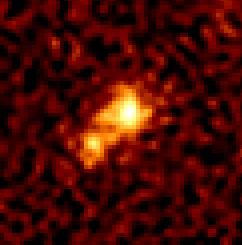
 The binary Kuiper Belt Object 1998 WW31 - Chapter 2
The binary Kuiper Belt Object 1998 WW31 - Chapter 2
Sharing information for a better knowledge of the binary system
C. Veillet - CFHT
2001 May 25 / 2002 April 11
| Back to the 1998WW31 story |
The discovery of the duplicity of 1998 WW31 has been announced on April 16, 2001. All the information relevant to this discovery itself is found here.
We present on this page the second phase of the work done on 1998 WW31.
In order to gather as much information on the system, I contacted all the colleagues who had already published positions of 1998 WW31. The oldest observations were made in the winter 1998-1999 and published in MPEC 1999-B24. Marc Buie (Lowell Obs.) and Matthew Holman (CFA) were contacted and joined the group. M. Buie had also made observations in Nov. 2000, published with the recovery positions from CFHT in MPEC 2001-G29. Joel Parker (SWRI- Boulder) had some unpublished observations from Nov. 1999 and proposed to join the group. David Tholen and Mike Connelley (IfA, Hawaii), who had taken three images in an attempt to recover 1998 WW31 just after our run at CFHT in December, were the last two to join the goup. Brian Marsden, who had helped with the first report on the discovery in early April, was already working with Alain Doressoundiram and myself.
Note added on April 12, 2002:This how we ended up with the list of authors you can see on the first published paper on 1998WW31 (the one in Nature - April 18, 2002). I proposed to all of them to share their data with me in exchange for their name on that paper... The following chapter shows how things moved ahead from this time consuming, but a bit disappointing, chapter.
Nov.
1998 - Kitt Peak 4-m reflector
In the three images of the discovery of 1998 WW31, the image of the
TNO is clearly elongated.
Dec.
1998 - La Palma Nordic Optical Telescope
The image quality on that night of observation is too poor to provide
any significant information on the pair.
Jan.
1999 - WIYN Telescope
Only a slight elongation seen: the pair seems to be very close.
Nov. 1999
- Kitt Peak 3.8-m reflector
The image quality on that night of observation is too poor to provide
any significant information on the pair.
Nov. 1999 - Kitt Peak 4-m reflector (unpublished
observations by J. Parker)
The elongation is clearly visible on these four images.
Dec. 2000 - CFHT 3.6-m reflector (unpublished
observations by H. Aussel for D. Tholen and M. Connelley)
Three nights after the binarity discovery observations by C.
Veillet and A. Doressoundiram, three additional images were taken on the
same telescope and the same instrument... One of the images nicely shows
the two components separated (as three days earlier).
Though we have only sparse data, often taken in conditions not really
optimal for the measurement of the orientation of the pair and the separation
of the two components, all the images where something was visible have
been processed, some of them twice independently, in order to get enough
information for the determination of the apparent orbit of the pair.

Assuming a circular motion of the faintest component around the brightest one, we find:
Period : 124.5 days
Epoch of NE elongation 2451904.30 (2000 December 25.8)
Position angle at NE elongation: 44.39 degrees
Apparent ellipse parameters: a = 1.28" b = -0.26"
rms of the residuals in distance between observed and theoretical
position : 0.08"
Data are unfortunately packed on a small part of the orbit. Though the above solution is by far the best fit to the observations, we have to be careful... Other orbits could go through our few points, even if not as well! See another orbit here!
Note added on April 12, 2002:At that time, we didn't envision a non circular orbit. We wouldn't have had enough data anyway to secure an eccentricity and a pericenter in addition to the other parameters to be determined!...
Relative photometry
Using all the CFHT images and the KPNO observations by J. Parker, the
relative magnitude in R is found as 0.49 +/- 0.06.
period : 124.5 days

Orbit 2
period : 415 days
